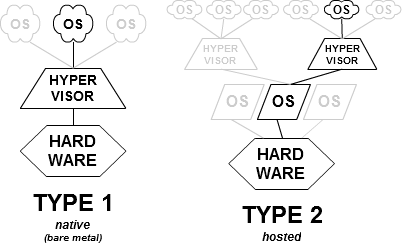Wiki: http://en.wikipedia.org/wiki/Hypervisor
Hypervisor = Virtual machine monitor
is a piece of computer software, firmware or hardware that creates and runs virtual machines.

Hypervisor = Virtual machine monitor
is a piece of computer software, firmware or hardware that creates and runs virtual machines.
A computer on which a hypervisor is running one or more virtual machines is defined as a host machine. Each virtual machine is called a guest machine. The hypervisor presents the guest operating systems with a virtual operating platform and manages the execution of the guest operating systems. Multiple instances of a variety of operating systems may share the virtualized hardware resources.
Two types:
- Type 1 (or native, bare metal) hypervisors run directly on the host's hardware to control the hardware and to manage guest operating systems. A guest operating-system thus runs on another level above the hypervisor.
- This model represents the classic implementation of virtual-machine architectures; IBM developed the original hypervisors as bare-metal tools in the 1960s: the test tool, SIMMON, and CP/CMS. CP/CMS was the ancestor of IBM's z/VM. Modern equivalents include Oracle VM Server for SPARC, Oracle VM Server for x86, the Citrix XenServer and VMware ESX/ESXi.
- Type 2 (or hosted) hypervisors run within a conventional operating-system environment. With the hypervisor layer as a distinct second software level, guest operating-systems run at the third level above the hardware. VMware Workstation and VirtualBox exemplify Type 2 hypervisors.

The classification of specific hypervisor implementations as Type 1 or Type 2 is not always clear cut. For example:
- Kernel-based Virtual Machine (KVM) is implemented as a kernel module for Linux 2.6.20 which, when loaded, allows the Linux kernel to operate as a bare-metal (i.e., Type 1) hypervisor.[2] However, as Linux is an operating system in its own right, one can argue that KVM is a Type 2 hypervisor.[3]
- Microsoft Hyper-V (released in June 2008)[4] has also been misidentified as a Type 2 hypervisor.[5] Both the free stand-alone version and the version that is part of the commercial Windows Server 2008 product use a virtualized Windows Server 2008 parent partition to manage the Type 1 Hyper-V hypervisor. In both cases the Hyper-V hypervisor loads prior to the management operating-system, and any virtual environments created run directly on the hypervisor, not via the management operating-system.
Attempts have been made to introduce the term Type 0 (Zero) Hypervisor to differentiate specific hypervisor implementations.[6][7] However, no consensus as to the validity of this term has been reached.[8]
-----
Several factors led to a resurgence around 2005 in the use of virtualization technology among Unix and Linux server vendors:[10]
- Expanding hardware capabilities, allowing each single machine to do more simultaneous work
- Efforts to control costs and to simplify management through consolidation of servers
- The need to control large multiprocessor and cluster installations, for example in server farms and render farms
- The improved security, reliability, and device independence possible from hypervisor architectures
- The ability to run complex, OS-dependent applications in different hardware or OS environments
No comments:
Post a Comment